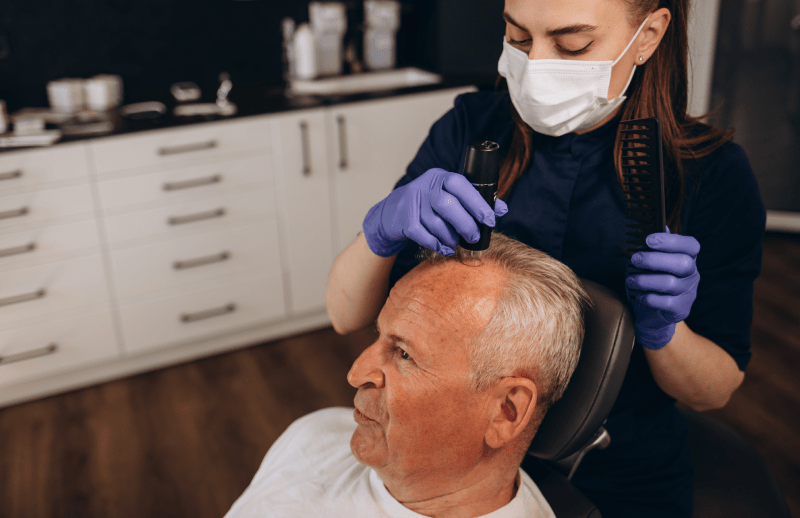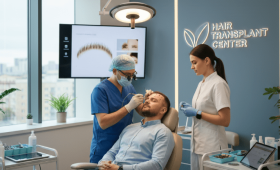Direct Hair Implantation (DHI) is one of the most precise and aesthetic methods among hair transplantation technologies. This technique, which performs both channel opening and graft placement in a single stage using special implanter pens, stands out particularly for its ability to allow unshaven transplantation and to provide high density among existing hairs.
Turkey offers this advanced technique with a world-class quality and at much more affordable costs compared to centers like the UK/London. To take the right step in your hair transplant journey and have a high-quality, comfortable experience, you must evaluate the opportunities in Turkey with the consultancy of Cure Holiday.
What Is DHI Hair Transplant And How Does It Work?
DHI Hair Transplant is a technique performed using special medical pens called the Chopper (implanter). Just like in the FUE method, grafts are first collected from the donor area, but there is no channel opening phase. The collected grafts are placed directly into these pens, and with a single motion, a micro-hole is opened in the recipient area, and the graft is instantly transplanted into this hole at the desired angle and direction. Thanks to this “direct implantation,” the waiting time of the grafts outside the body is minimized, their viability rates are preserved, and the risk of damaging existing hair nearby is reduced, which speeds up the recovery process.
What Is The Fundamental Difference Between DHI And FUE?
In the FUE technique, after the graft is harvested, channels are first opened in the transplantation area using scalpels or sapphire blades, and the grafts are then placed into these channels. The fundamental difference of the DHI Technique is that the channel opening and graft placement processes are performed simultaneously via Chopper Pens. This ensures that grafts spend less time outside, there is less bleeding, and denser transplantation is possible. This feature makes DHI a much more attractive option, especially for patients who want high density in narrow areas or prefer unshaven transplantation.
Why Is Shaving Not Mandatory In DHI?
Thanks to the small and precise structure of the implanter pens, the DHI technique largely eliminates the necessity of shaving the recipient area. It is ideal, especially for female patients or individuals with non-advanced hair loss who wish to preserve their existing hair. Grafts can be placed directly among existing hair strands at millimeter-precise angles. However, shaving the donor area (usually the nape) is generally required for easier and healthier graft collection. This allows patients to return to their daily lives more quickly and without aesthetic concerns.
How Is The Most Natural Hairline Created With DHI?
DHI ensures that the exact direction, angle, and depth of the hair roots are controlled, thanks to the implanter pen’s ability to be rotated 360 degrees and adjusted. This precision allows for the opening of micro-channels that are entirely consistent with the person’s natural hair growth direction, especially when creating the frontal hairline. Hair transplanted with the correct angle and density exhibits perfect harmony with other hair as it grows, preventing an artificial look. Turkish specialists working with Cure Holiday have extensive experience in natural hairline design.
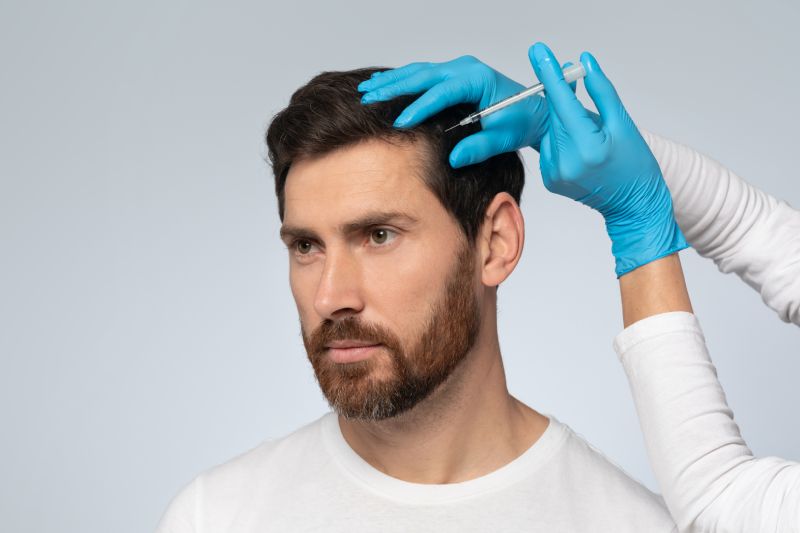
What Factors Determine DHI Hair Transplant Prices?
DHI Hair Transplant prices vary according to the number of grafts used, the experience of the team performing the operation, and the country where the clinic is located. Since the DHI technique requires more time and precise equipment (Chopper pens) compared to FUE, it is more expensive in countries like the UK. However, in Turkey, thanks to the high volume of operations and low operating costs, DHI is offered in affordable, all-inclusive packages. Therefore, when researching prices, it is important to check the scope of the package offered, not just the technique.
What Is The Success Rate Of The DHI Operation?
The success rate of the DHI operation largely depends on the viability time of the grafts. Thanks to the Chopper pen performing the harvesting and placement instantly, the grafts spend very little time outside the body. This minimizes the risk of graft loss and increases the chance of hair roots taking hold in their new location. With a successful operation and proper post-operative care, engraftment rates up to 95% can be seen with DHI. Experienced centers working with Cure Holiday regularly demonstrate these high success rates.
For Whom Is DHI An Ideal Option?
DHI is an ideal option especially for individuals whose hair has not completely fallen out, who want to increase hair density (densification) or are looking for unshaven transplantation. Furthermore, patients seeking high-density and natural results in small areas like the frontal hairline should prefer DHI. However, FUE or other combined techniques may be more suitable for individuals with a weak donor area or those who require transplantation over a very wide area. Specialists determine the most suitable technique after evaluating the person’s hair loss condition.
How Are Grafts Harvested In The DHI Application?
The graft harvesting process in DHI application proceeds similarly to the traditional FUE technique. After the donor area is numbed with local anesthesia, hair roots (grafts) are loosened and extracted one by one using special tools called the micro motor or manual punch. After collecting quality and healthy grafts, they are quickly placed into the Chopper pens without waiting, and the transplantation process begins. Quick harvesting and quick placement are two critical steps that constitute the core success of DHI.
What Are The Advantages Of Using The DHI Pen?
The greatest advantage of the DHI pen (Chopper) is that it combines the channel opening and graft placement processes into a single step. This results in less trauma during the transplantation, minimizes bleeding, and speeds up the recovery process. Furthermore, the pen offers the ability to precisely adjust the angle and depth at which the graft will be placed, leading to a highly natural-looking result. In Turkey, this advanced technology is applied in the best way through Cure Holiday, proving the quality of the results internationally.
How Intense Is The Pain And Aching Sensation In DHI?
Since the DHI operation is performed under local anesthesia, the pain or aching sensation is minimal. There might be a slight stinging sensation during the application of the anesthesia, but this feeling is generally short-lived. In many modern centers in Turkey, even this initial sting can be eliminated using needle-free anesthesia devices. After the operation, any slight soreness or tension can be easily controlled with painkillers prescribed by the doctor, thus keeping patient comfort at the highest level.

How Many Grafts Can Be Transplanted With The DHI Technique?
The number of grafts that can be transplanted in one session with the DHI Technique is usually slightly more limited compared to FUE (averaging 2,500–4,000 grafts). The reason for this limitation is that DHI is a more meticulous and time-consuming process. The management of a single pen and the individual placement of grafts extend the duration of the operation. However, DHI can provide higher density than FUE, even with fewer grafts, because transplantation can be done much more closely among existing hairs.
How Long Does The Recovery Process Take After DHI?
Since no channel opening is performed in the DHI technique, skin trauma is minimal, and this situation accelerates the recovery process. Generally, within the first 7–10 days, the crusts in the transplantation area start to fall off, and redness decreases. Returning to a completely normal appearance takes about 2–3 weeks. Clinics in Turkey, with special care products and instructions provided within Cure Holiday packages, help you navigate this process in the most comfortable way.
When Do Crusting And Redness Disappear?
The micro-level crusting and slight redness that occur in the area transplanted with the DHI technique usually begin to fall off after the first washing procedures, generally 7 to 10 days after the operation. The redness in the transplanted area disappears completely within 2 to 4 weeks, depending on skin sensitivity. During this process, protecting from the sun and using the special lotions recommended by the doctor are vital for accelerating recovery and alleviating redness.
Is The Shock Loss Process Different In DHI?
The shock loss process, like FUE, is an expected and normal process in the DHI technique. Approximately 2 to 8 weeks after transplantation, a large portion of the transplanted hair temporarily falls out. The speed or severity of this shedding in DHI is generally independent of the technique, although some experts suggest that due to the minimal trauma of DHI, this process might be slightly milder. The important thing is that the roots of the shed hairs remain intact, and they will start growing back after about 3 months.
When Should The First Wash Be Done After DHI Transplantation?
The first wash after DHI Transplantation is usually performed by specialists at the clinic 48 hours (day 2) after the operation. This initial wash must be done extremely gently with special lotions and carefully to avoid damaging the newly transplanted grafts. This first wash in the clinic environment is also critical for teaching the patient the correct technique for subsequent washes at home. The mandatory first wash service is included in the packages of centers contracted with Cure Holiday.
When Does Hair Start To Grow Completely?
The majority of the transplanted hair starts to grow back permanently after the shock loss, around the 3rd to 4th month after the operation. Initially thin and weak, these hairs thicken and strengthen over time. While 70-80% of the results are usually seen in the 6th to 9th months, it may take 12 to 18 months for the hair to achieve its full density and final quality. This is a process that requires patience, but the results are permanent.
Can Thin Hairs Be Used In The DHI Technique?
Thanks to the precision provided by the implanter pens and the micro-level channels, the DHI technique allows even thin hairs to be transplanted safely and at the correct angle. Thin hair strands can be preferred, especially in areas targeting a natural transition, such as the frontal hairline. However, DHI requires the use of pen tips appropriate for the graft’s diameter, so healthy harvesting is always a priority. Experienced teams aim to achieve the best result by selecting the most suitable grafts in the donor area.
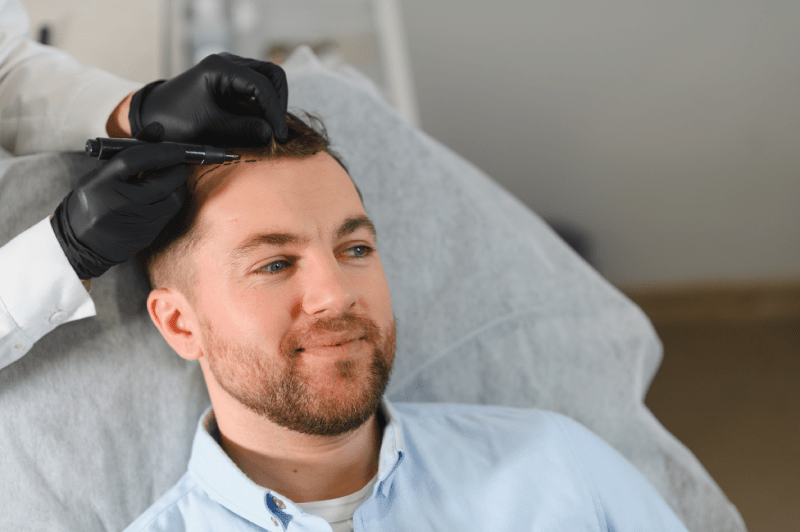
How Is Hair Density Increased With DHI?
DHI allows for much denser and more controlled transplantation among existing hair strands, thanks to the millimetric control provided by the special pens. While tight transplantation may be avoided in traditional methods due to the high risk of damaging existing hair, this risk is low with DHI. This makes DHI an ideal solution for patients who want to achieve high density in areas that are not completely bald but are thinning.
Does It Damage Existing Hair?
One of the most significant advantages of the DHI technique is that the risk of damaging existing healthy hair during the transplantation process is minimal. The implanter pen places the graft by opening only a small hole among the existing hair roots, without touching them. This feature makes DHI the primary choice for operations aimed at densification and preserving existing hair. Thus, both new and old hairs are ensured to continue growing healthily after the transplantation.
Can DHI Be Used For Beard And Eyebrow Transplantation?
Yes, the DHI technique is also ideal for esthetically critical areas such as beard and eyebrow transplantation, thanks to the high precision and angle control it offers. In eyebrow transplantation, the exit angle of the hairs (almost parallel to the skin) is vital, and the DHI pen fully provides this. In beard transplantation, the DHI technique is frequently preferred to achieve a high-density, natural appearance. Hair transplant Centers in Turkey offer advanced expertise in these special types of transplantation with the assurance of Cure Holiday.
How Long Does The DHI Operation Take?
The DHI operation usually takes longer compared to FUE and can range between 6 and 9 hours, depending on the number of grafts. The reason for this is that each graft needs to be individually loaded into the pen and meticulously placed. The long duration of the operation demonstrates the meticulousness of the procedure, and short breaks are given at specific intervals to prevent team fatigue. Centers working with Cure Holiday provide special rest opportunities during the operation to ensure patient comfort.
Does The Donor Area Leave A Scar?
In the DHI technique (and FUE), since the grafts are harvested with micro motors, no permanent scar or stitch mark is left in the donor area. Recovery in the donor area is usually very fast and returns to its completely normal appearance within 10 days. As long as it is not closely shaved, it will not be noticeable that hair was taken from the harvesting area. This scarless recovery is one of the aesthetic advantages offered by DHI and allows patients to quickly return to social life.
What Preparations Are Required Before The Surgery?
Before DHI surgery, the patient needs to stop using alcohol and cigarettes at least one week before the operation, discontinue blood-thinning medications (with doctor approval), and arrive on the day of the operation wearing clean, comfortable clothes. Furthermore, beverages that can increase bleeding, such as coffee, should be avoided. Cure Holiday consultants provide a detailed preparation list for their patients, ensuring all necessary steps are taken for the success of the operation.
How Is Hair Direction Determined With DHI?
Determining the hair direction is the strongest aspect of the DHI technique. Since the surgeon using the Chopper pen places the graft at the same time as opening the micro-channel for transplantation, they can adjust the angle and direction of the graft millimetrically. This allows the hair to grow in the same direction as the existing hair, with a natural slope. Experience and aesthetic vision play a critical role in correctly determining the hair direction and prevent the results from looking artificial.
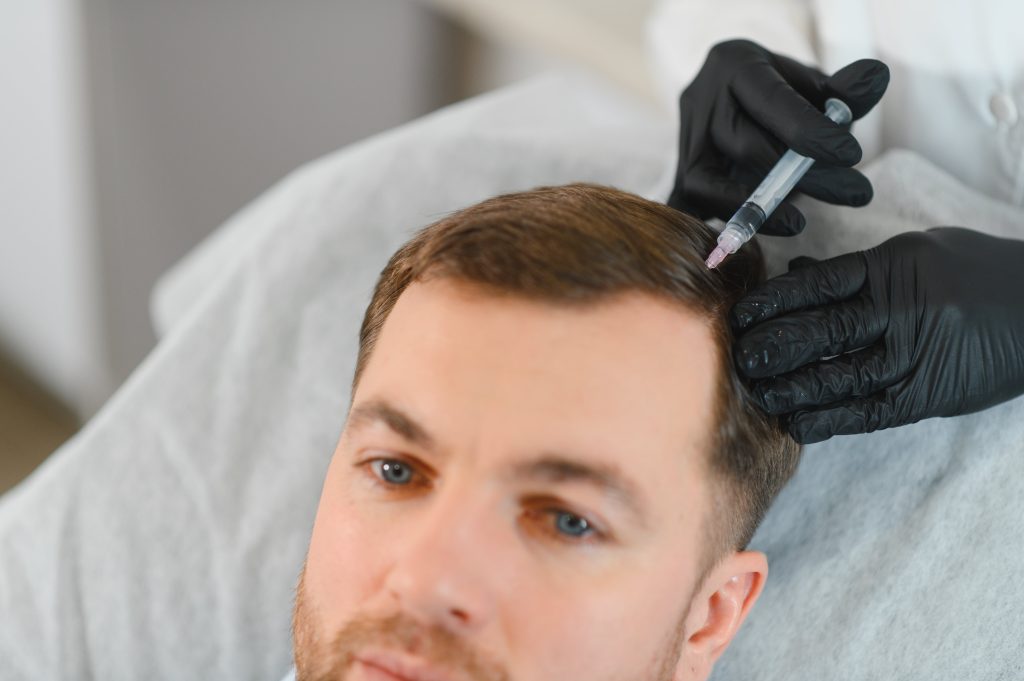
Are Multiple DHI Sessions Necessary?
The need for multiple DHI sessions depends on the patient’s hair loss level, donor area capacity, and the desired density to be achieved. In cases of advanced hair loss or when very high density is desired, a second session may be needed after 8-12 months to allow the donor area to rest. However, since DHI provides high density in the first session, it can reduce the need for a second session in some cases compared to FUE.
Is The DHI Technique Suitable For All Types Of Hair Loss?
The DHI technique is suitable, especially for patients with Androgenetic Alopecia (male pattern baldness) and stabilized hair loss. While FUE may be faster for those needing a high number of grafts in large areas, DHI is more suitable for specific types, such as frontal hairline reconstruction, crown area densification, and female pattern hair loss. The suitability should be determined by a specialist after evaluating the patient’s donor capacity and hair analysis.
What Are The Special Care Products After The Operation?
Special care products that the patient must use after the operation include pH-adjusted sensitive shampoos, healing-supportive lotions (foams), B vitamins, and sometimes products like Minoxidil to support hair growth. The purpose of these products is to support the fast and healthy recovery of the transplanted and donor areas. All these necessary care products for the first week are offered free of charge in the all-inclusive packages of Cure Holiday.
When Can Sports Be Started?
Light exercises (such as walking) can usually be started after the first week following a hair transplant. However, intense sports activities involving heavy lifting, swimming, running, or causing sweating must be avoided for at least 1 month. Heavy sweating can increase the risk of infection in the transplanted area and cause the grafts to shift out of place. Adhering to this rule for the first month is mandatory for successful recovery.
How Should One Protect From Sunlight?
Since sunlight can damage the newly transplanted grafts and healing skin, absolute protection is required for the first month after the operation. Direct exposure to sunlight should be avoided, and a wide-brimmed hat that does not put pressure on the grafts should be worn when going outdoors. Sun protection is also vital for preventing the redness in the transplanted area from turning into a permanent color (hyperpigmentation).
What Should The Sleeping Position Be During The Recovery Period?
The sleeping position during the recovery period is critical for protecting the transplanted grafts. It is recommended that the patient sleep on their back with their head slightly elevated for the first 5-7 days. The special neck pillow (donut pillow) provided by the clinic should be used to prevent the transplanted area from rubbing or being pressured by the pillow. Prone or side sleeping positions can damage newly transplanted grafts and negatively affect success.
Why Should DHI Hair Transplant Be Preferred In Turkey?
DHI Hair Transplant should be preferred in Turkey due to both high experience and cost-effectiveness. Centers in Turkey have specialized in advanced techniques like DHI thanks to the high volume of international patients and offer these operations in all-inclusive packages at a fraction of the cost in the United Kingdom. It is the most reliable way to achieve your aesthetic goals without compromising on quality and while protecting your budget.
What Advantages Does Cure Holiday Offer In Turkey?
Cure Holiday connects patients with internationally accredited centers in Turkey that only work with the best DHI specialists. The advantages we offer include VIP transfers, luxury hotel accommodation, interpreter service, lifetime online follow-up, and transparent, all-inclusive packages that cover all post-operative care products and medications. Our patients’ sole focus should be on a successful operation and a quick recovery process.
How Is The Graft Viability Time Managed In The DHI Method?
The main advantage of the DHI method is that the waiting time of the grafts outside the body is very short. Grafts are placed into special Chopper pens immediately after harvesting and are instantly implanted. If grafts are kept outside, they rapidly lose their viability. DHI maximizes the viability rate of the grafts by shortening this period, thereby directly increasing the success of the transplant. This fast and direct implantation process is the technological difference that makes DHI superior.
When Are Permanent Results Seen After DHI Transplantation?
Permanent results after DHI transplantation generally fully emerge 12 to 18 months after the operation. During this time, the transplanted hair thickens, matures, and reaches its final density. Although results start to become noticeable in the first six months, being patient and following the doctor’s advice guarantees the best permanent results. This process is time-consuming by the nature of new hair growth and may progress slightly differently for each patient.
Can DHI Prices Be Compared With Turkey Packages?
While DHI prices in countries like the UK typically cover only the operation itself, Turkey packages offer “All-Inclusive” solutions covering the operation, accommodation, transfers, care products, and medications at a cost far below that price. Therefore, it is possible to compare the cost of a single graft fee in the UK with a comprehensive DHI package in Turkey. Considering the price-quality balance, the options in Turkey are clearly superior.
DHI Hair Transplant is an excellent solution for patients seeking a natural look and high density. However, high costs can make achieving this aesthetic goal challenging. As Cure Holiday, we direct you to Turkish centers that offer the most advanced applications of the DHI technique at a price far below the costs in the United Kingdom.
Contact Cure Holiday today to start your hair transplant journey and receive your personalized DHI package offer. Our specialists will be happy to provide you with a free preliminary evaluation and a detailed treatment plan.
